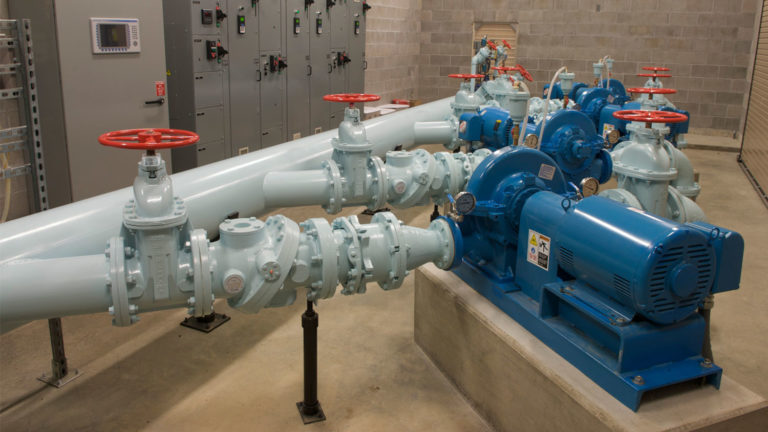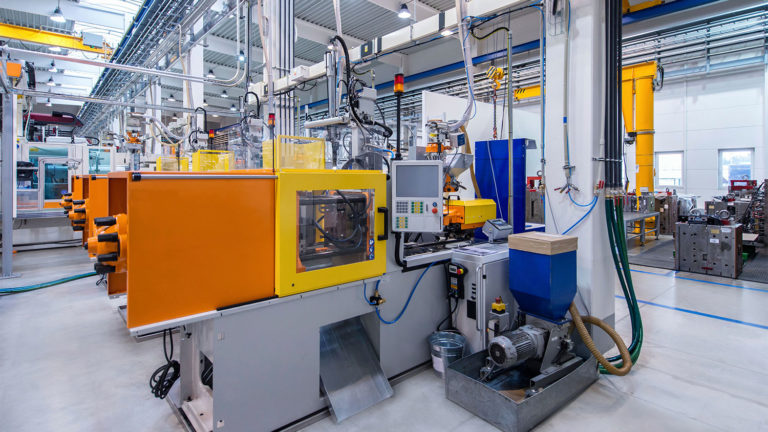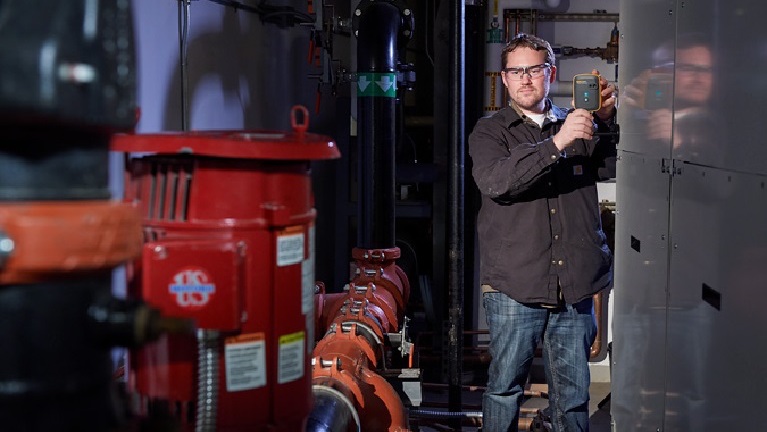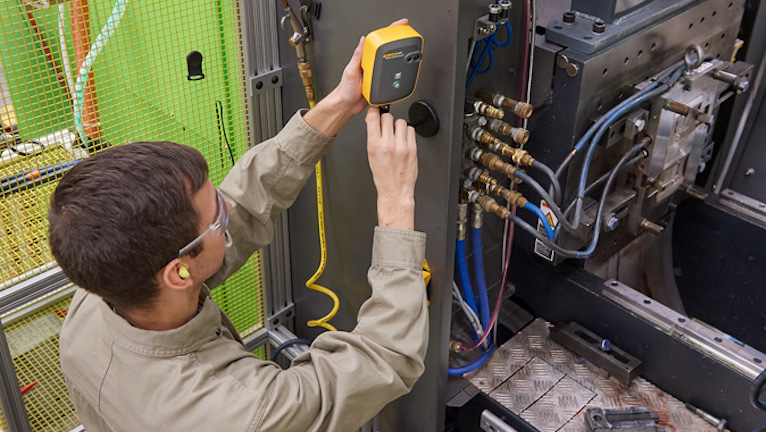How to Use the P-F Curve to Plan Maintenance
There are three core tools in the Reliability Professional’s belt: Root cause analysis (RCA), Failure Modes and Effects Analysis (FMEA), and the P-F curve. In a September 2020 webinar, three Fluke Reliability experts with years of plant floor experience outlined how to use the P-F curve and FMEA together. For example, use both to detect the full range of failure indicators across an asset’s lifespan.
“The point at which your ‘check engine’ light comes on in your car is dependent upon what symptoms the system is looking for. Using the P-F curve and failure mode analysis, if you know what the earliest signs of trouble look like for your equipment, you can start detecting the very earliest signs of failure—if that’s what makes sense to do. “
Gregory Perry, Senior Capacity Assurance Consultant
Fluke Reliability experts agreed. Not all machines are going to be on condition-based maintenance. No world-class company is going to be 100% condition-based maintenance. Plants need to run a mix of scheduled, reactive, and condition-based maintenance strategies.
“Do a failure mode analysis for the critical equipment in your plant and find out what you need to be testing for…and match the right tool to the expected failure mode. Don’t just have a thermal camera and say, ‘I’m doing predictive maintenance,’ because you’re only doing part of it. There’s ultrasound, vibration, motor testing, electrical testing, and oil analysis to consider.”
John Bernet, Mechanical Application and Product Specialist
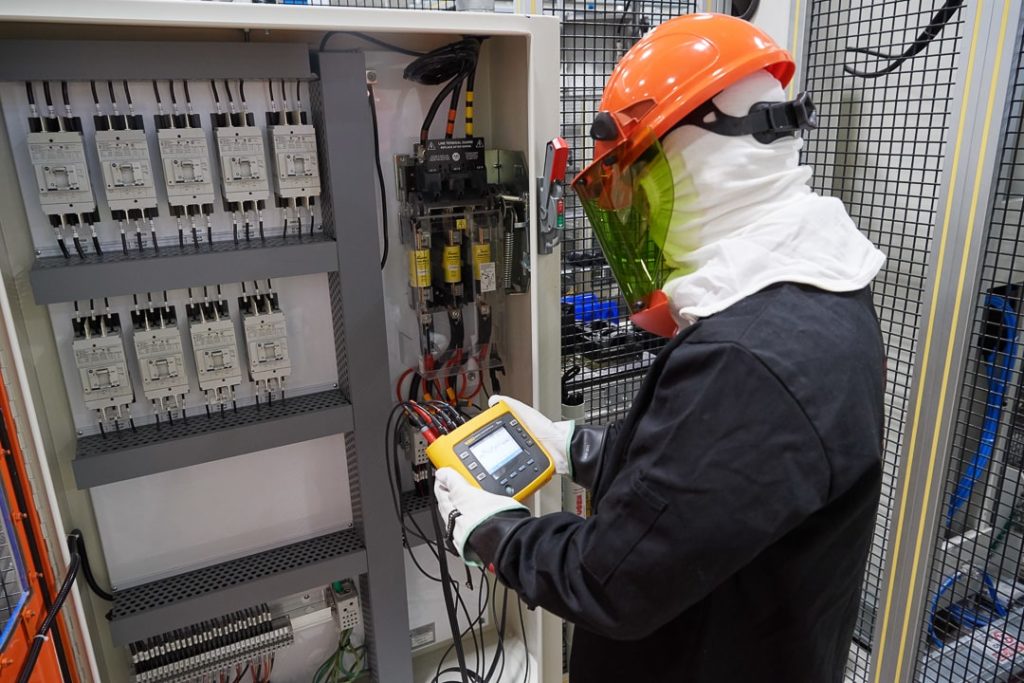
What is the P-F Curve
The P-F curve is a graph representing the decline of asset health over time, from engineering to decommissioning. The P-F portion refers to the Potential Failure curve at the latter end of an assets’ lifecycle. This is where a potential failure and functional failure intersect. Methods of detection along the P-F Curve vary depending on assets, potential failure types, and your planned maintenance.
READ MORE: The P-F Curve Explained: History, Definition, Importance
The big questions are: Which machines should you be monitoring with condition-based maintenance? And, which do you just use scheduled maintenance? That’s where the P-F curve and FMEA come in.
“The P-F curve maps the different techniques. Which one you choose really depends on which failure mode you’re looking for. It’s by using a combination of multiple techniques that you get the full picture—there’s not one holy grail.”
Dries Van Loon, Sales and Project Manager for Online Condition Monitoring
P-F curve basics
Many maintenance and reliability professionals use Stanley Nolan and Howard Heap’s P-F curve to map equipment health. “P” stands for potential failure. “F” stands for functional failure, The P-F Interval is the time it takes for an asset to functionally fail once a possible failure has been detected.
The right side of Figure 1, labeled Inherent Availability, depicts an asset’s gradual failure over time. Note the maintenance tasks and techniques along the curve: different failure indicators are detectable at different times within the P-F interval. For critical assets, the sooner you detect a failure, the more effective maintenance can be to prolong the asset’s life.
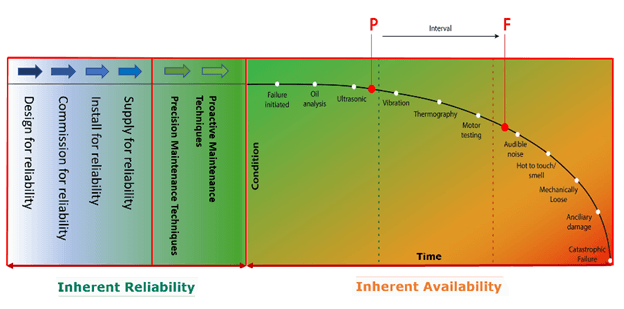
As Perry explains during the webinar, “availability” refers to a machine’s “steady state” capability at the start of its operational life.
“Maintainability (inherent availability) seeks to restore functionality to a maximized (inherent reliability) state to be ready for its next mission. We call this harvesting full-capacity on the PF. Attainability (inherent reliability) seeks to achieve the ‘upper limit’ of a machine’s availability earlier on. You can achieve this through proper design, commissioning, installation (precision maintenance), and proactive maintenance techniques. We call this ‘left of the PF’.”
Greg Perry
Failure modes and the P-F Curve
However, what machine health data do you collect, when, to increase inherent availability?
“The asset’s original equipment manufacturer (OEM) is a great first source for that model’s most significant failure indicators. When that’s missing, failure analysis tools and techniques—FMEA, reliability centered maintenance (RCM), 5-Why, Logic Tree, data analytics, and others—can help map failure indicators to the correct maintenance activity.”
Greg Perry
Figure 2 asks, from what you know of the machine and its failure indicators, when should you rely on data analysis, condition monitoring, non-intrusive measurements, or physical inspection?
Map the colors of the failure modes to the P-F curve. The earlier in the curve, the more relevant your data and condition monitoring analysis will be. Later in the curve, time-based measurements and inspections will be more relevant, though this is not necessarily a linear process. Most importantly, the techniques in Figure 2 provide the means to procure the asset or component health data that will help the team increase the asset’s inherent availability.
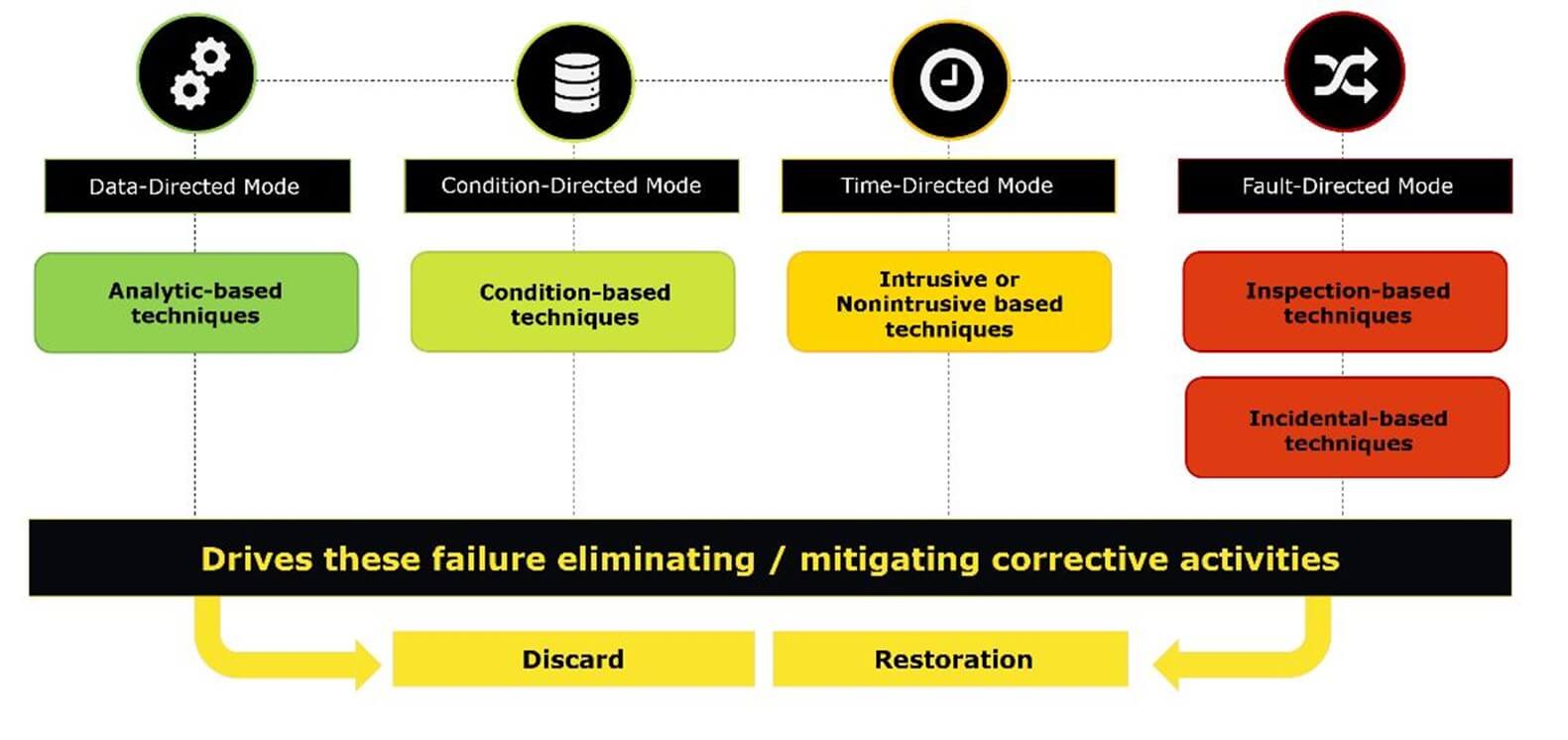
Inspection Methods Along the P-F Curve
In the second part of the webinar, Van Loon and Bernet discuss which failure modes can be best detected using different inspection methods.
Oil Analysis
Oil analysis is used to inspect oil-cooled components of rotating equipment, including gearboxes, sleeve bearings, reciprocal engines, and compressors. You can use oil analysis to assess hydraulic systems and components’ health to detect wear and overload. The analysis can detect lubrication breakdown, overheating, component wear, and wear particles. These indicators are particularly useful for detecting signs of bearing wear or failure, gear failure, or cylinder wear. Apply different types of oil analysis methods depending on the asset conditions. Advanced online monitoring and oil analysis can prevent unplanned failures. Lab analysis and basic monitoring will diagnose conditions. In addition, screen equipment in time-based maintenance using an oil sight glass or oil temperature measurements.
Ultrasound
Ultrasound often helps determine the root cause of failure modes. Use ultrasound testing on both machine components as well as systems and pipes to find:
- Air, refrigerant, gas, or ammonia leaks
- Valve actuator problems
- Steam trap problems
- Bearings that need lubrication
- Electrical safety hazards
- Tank tightness checks
Vibration Analysis
Vibration analysis is leveraged in both condition monitoring and RCA. When performed on rotating equipment, you can detect mechanical faults. Vibration signature analysis can reveal signs of imbalance, misalignment, looseness, bearing failure, electrical failure, and even process issues with flow or pressure.
“Use the asset criticality and failure modes to determine which vibration method to use and when.”
Van Loon
For example, you can use a vibration meter to make time-based maintenance screening checks. Afterward, you can compare current and historic readings. However, you won’t see around-the-clock data. Conversely, vibration sensors offer improved analytical benefits due to the increased number of measurements taken. More data means you can better compare and analyze findings.
Thermography
Thermography is best for finding electrical problems and severe mechanical issues that are causing the system to overheat. Shaft misalignment, gearbox issues, and belt problems are all detectable with thermography. However, beware, by the time a machine’s temperature is elevated enough to be noticeable with thermography, damage may have already occurred. That’s why you’ll find thermography further to the right of the P-F curve as a time-directed or fault-directed inspection. Use it in combination with the other measurement methods so that you can cover all four modes.
Motor Testing
Motor tests are conducted in two different machine states: energized (operating) or de-energized. These tests occur toward the curve’s right and are used for time-based inspection and fault diagnosis. Energized tests include an insulation test, motor current, motor circuit spectrum analysis, power factor, and harmonic distortion. De-energized tests include surge testing, hi-pot testing, megohmmeter, and motor circuit analysis.
Which P-F Curve Method is Best?
So, which of these maintenance methods should you apply the most? In a survey of the 254 live webinar attendees, more than 82% said vibration monitoring and analysis. Many also use other methods for various assets too. Some 69% use thermography, 65% oil analysis, 54% motor testing, and 36% ultrasound.
Bernet cautions against trying to use one tool to measure everything—assets don’t behave that way. Different components fail in various ways. He advises:
- Think about your assets holistically — as a system and as distinct components — because it’s vital to watch for specific failure modes from each aspect.
- Focus on the expected failure modes and match the inspection technique to the urgency of the machine status.
- If asset criticality supports maximizing the machine’s lifespan and availability, use monitoring and data analysis to protect each link in the chain.

To learn more about using P-F curve methodologies in asset maintenance plans, please speak with one of our customer success managers!
Related articles:
A-B-Cs of the P-F curve
When and how to use and set up vibration monitoring on assets
Webinar: Proactive maintenance strategies to extend the life of your assets
Maintenance automation and the P-F curve

